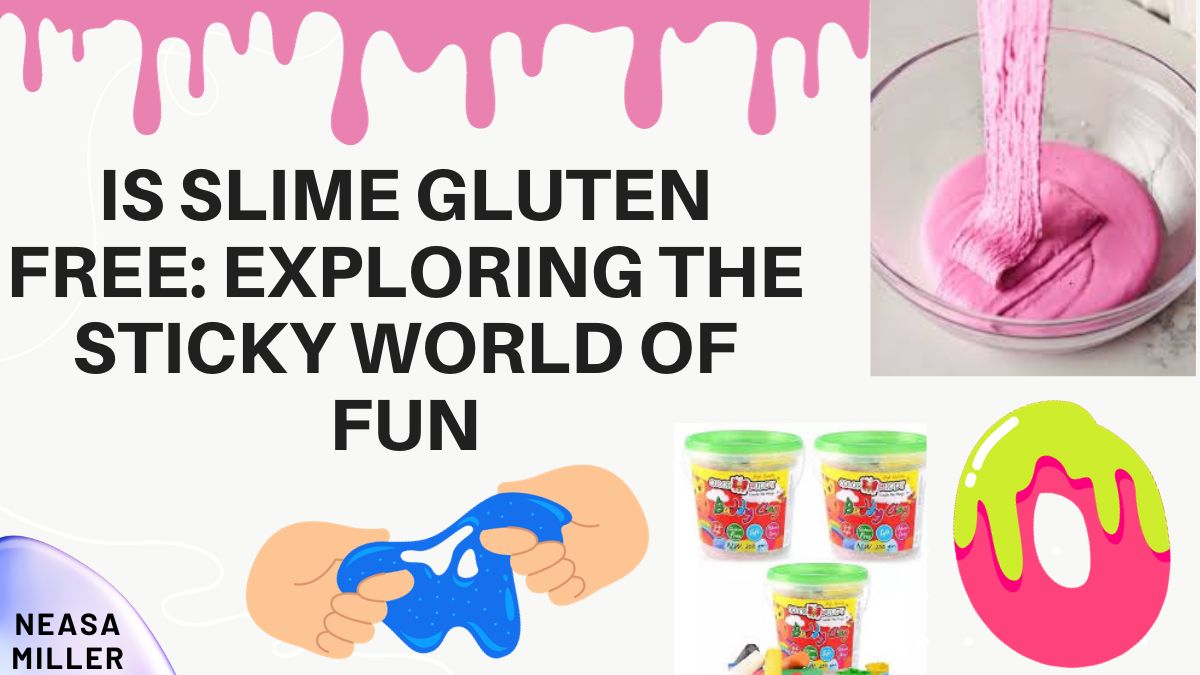Does slime contain any gluten is a frequent query in the world of many pastimes and artistic outlets today. This query is crucial for those who have embraced the fad of creating and playing with slime. As we already discussed regarding gluten sensitivities in our earlier posts, finding gluten-free treats can be a challenge. This blog post will explore the fascinating world of slime, look at its constituents, and answer the question: Is slime gluten-free?
Overview of the Slime Craze
Let’s take a moment to savor the gluten-free component before moving on to the slime frenzy itself. More than just a kid’s toy, slime has evolved into a captivating sensory experience for people of all ages. Slime is a unique way to relax and have fun because it feels good to squeeze and stretch it.
But why is slime so intriguing? Slime has a certain allure that may be attributed to its captivating color swirls, satisfying squelches, or limitless creative potential. Making slime has even become an art form, with people experimenting with various textures, hues, and ingredients to produce the ideal slime masterpiece.
What is Used to Make Slime?
We must first comprehend slime’s basic components to establish if it is gluten-free. Typically, slime is made up of three main parts:
1. Glue: Glue is the main ingredient in most slime recipes. The necessary stickiness is provided by this adhesive component, which enables slime to stretch and mold. The good news for those who are sensitive to gluten is that common glues like white and clear are gluten-free.
2. Activators: The secret to converting glue into slime is activators. Borax, saline solution, and liquid starch are typical activators. By joining with the glue molecules, these chemicals produce the necessary slime consistency. Thankfully, these activators are gluten-free as well.
3. Ingredients: Things can get difficult with additives. While many slime fans like enhancing their creations with numerous components, some additives might include gluten. If you have dietary requirements, you must read labels and select gluten-free products.
The steps to making slime are as follows:
- Prepare your workspace and materials.
- Mix glue and water until smooth.
- Add optional additives like color, glitter, or scent.
- Gradually add the activator while stirring until the slime forms
- Knead the slime by hand to improve its texture and elasticity.
Making slime is a fun and creative hobby where you may experiment with different materials to make the ideal slime.
Does slime include gluten?
The main components used to manufacture slime are often gluten-free. However, as was already indicated, gluten can potentially be present in additives.
Here are some steps you can take to guarantee a gluten-free slime experience if you’re worried about the gluten level of your slime:
Verify Labels: Any additives or colorants you intend to employ in your slime should be read on the labels. For further information, check for a gluten-free certification or get in touch with the producer.
Slime manufactured at home: Take into account utilizing gluten-free components to make your slime. You have complete control over what enters into your slime in this manner.
Slime from the store: If you like pre-made slime, check for items with transparent ingredient lists. There are currently numerous trustworthy makers of gluten-free slime.
Why Gluten-Free Slime Matters
You might be asking why there is even a conversation about gluten-free slime. Well, avoiding gluten is essential for the health and well-being of people with celiac disease or gluten sensitivity. In certain people, even tiny amounts of gluten can cause negative effects.
Therefore, we produce a secure and fun sensory experience for everyone, regardless of their dietary concerns, by making sure that slime is gluten-free.
How to Choose Gluten Free store For Slime
There are certain important factors to take into account while selecting gluten-free store-bought slime.
- The product labels should be carefully studied beforehand. Search for brands of slime that expressly claim they are gluten-free. According to these labels, the manufacturer has taken precautions to guarantee that the components used to make the slime are free of gluten contamination.
- If a slime product doesn’t have a gluten-free label, it’s best to get in touch with the producer to find out more about the ingredients and possible cross-contamination hazards. Manufacturers frequently respond to consumer questions and can provide you with the details you need to make an informed choice.
- Another choice is to look for reputed slime manufacturers who pride themselves on creating gluten-free goods. Consumer recommendations and online reviews can be helpful in this regard.
You may enjoy the world of store-bought slime with confidence by being careful when making your choice and doing some research, knowing that you’ve selected a gluten-free product that adheres to your dietary preferences or sensitivity.
Slime and Dietary Restrictions Of Slime
Certainly, the following are some essential details about “Slime and Dietary Restrictions”:
– Gluten Sensitivity and Celiac Disease: People who are sensitive to gluten or have celiac disease need to be on the lookout for any possible gluten exposure in their hobbies and daily activities, including making slime.
– Contents Matter: Check all of the slime’s contents, especially the additives and colorants, as some of them might contain gluten or have been processed in a facility that uses gluten.
– Gluten-Free Slime Options: Look for recipes and products labeled as gluten-free and gluten-free in particular. As a result, it is guaranteed that all ingredients, including glue and activators, are suitable for people who have dietary restrictions.
– Homemade Control: You have more control over the ingredients when producing slime at home, which makes it simpler to make a gluten-free version. Select gluten-free glue and activators, and stay away from gluten-containing additives.
– Cross-Contamination Awareness: Be aware of the potential for cross-contamination when using utensils or sharing slime with people who may have touched gluten-containing products.
– Reading Labels: Make sure all additives, colorants, and any fragrant oils you use are gluten-free or marked as such by carefully reading the labels.
– Consulting Manufacturers: If unsure of a store-bought slime product’s gluten content, get in touch with the maker to get further information.
– Enjoying Safe Sensory Play: People with dietary limitations can experience the sensory delight of playing with gluten-free slime safely by paying attention to the ingredients and possibilities for cross-contamination.
These key points emphasize how crucial it is to keep dietary limitations in mind when participating in slime-related activities.
Conclusion
In conclusion, the majority of people do like making slime without consuming gluten. Glue and activators, which are the main components used to make slime, are gluten-free. However, it’s important to use caution when adding additions to your slime if you have gluten allergies.
Rest assured that you may indulge in this interesting activity without having to worry about gluten, regardless of whether you’re a seasoned slime aficionado or someone new to the realm of sticky creativity. Create your colorful, flexible, gluten-free slime creation now!
Related Posts

I’m Neasa Miller, a professional dietitian with 5 years of experience. I founded glutenfreelifestyles.org to assist people online in embracing gluten-free living. Read more about me
